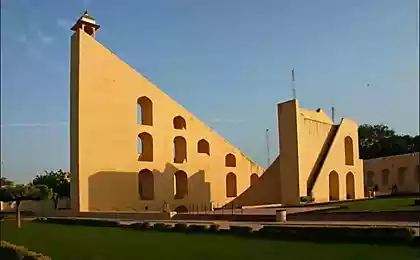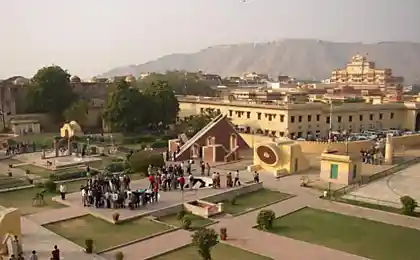767
Pushchino Radio Astronomy Observatory
In the March post AlleOpp told about radio telescope DKR-1000. Now the story goes about the BSA about the RT-22 (in addition to the theme that has already been, but from a slightly different angle, for the connection of the narrative), and a few artifacts.
Pushchino Radio Astronomy Observatory, Astro Space Center - the oldest scientific institution in Russia, engaged in radio astronomy.
It was founded April 11, 1956, when the Order was signed by the Council of Ministers authorizing the USSR Academy of Sciences to build in the Serpukhov district building a radio astronomy station of FIAN and install on the station Radio Telescope.
28 ph © Russos
1. LPI BSA radio telescope - this array, consisting of 16,384 vibrators located on an area of more than 7 hectares.

Now in the observatory are two and a half (the telescope DKR-100 is only east-west axis. The axis of North-South due tsvetmetchikov incapacitated) radio telescope:
1. The radio telescope RT-22 LPI - a radio telescope with a parabolic reflector with a diameter of 22 m. Was put into operation in late 1958, and was the world's first major radio telescope capable of operating in the millimeter wave band. Work on the creation of this telescope was conducted over several years at the Physics Institute. Lebedev USSR Academy of Sciences, with the participation of a number of design organizations and industrial enterprises. The supervisor of works on creation of the radio telescope was the USSR State Prize Laureate, Dr., AE Salomonovich, chief designer - Ph.D., PD Kalachev.
2. Radio telescope DKR-1000 - radio telescope of the meridian type unfilled aperture, consists of two antennas North-South and East-West, located in the shape of a cross. This tool is working only east-west direction.
3. The radio telescope BSA FIAN - this array, consisting of 16,384 vibrators located on an area of more than 7 hectares. Operating Wavelength - 3 m., And this range is the most sensitive BSA telescope in the world.
2. Wire the horizon.

3. RT-22 fote array.

4.
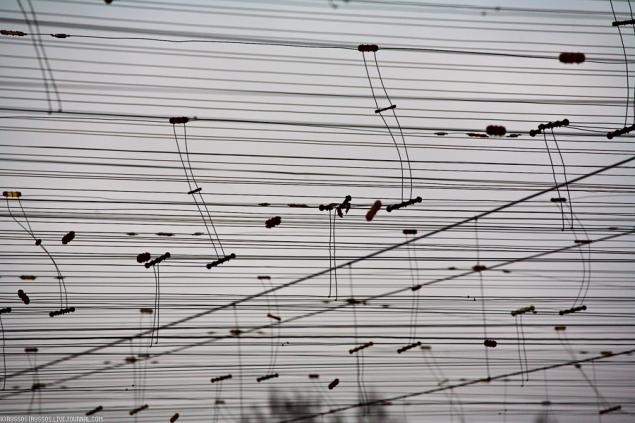
5.

6. DKR-1000 against the backdrop of the BSA.

7. Let's finally turn to the classical radio telescope - RT-22.

8. The central container equipment.
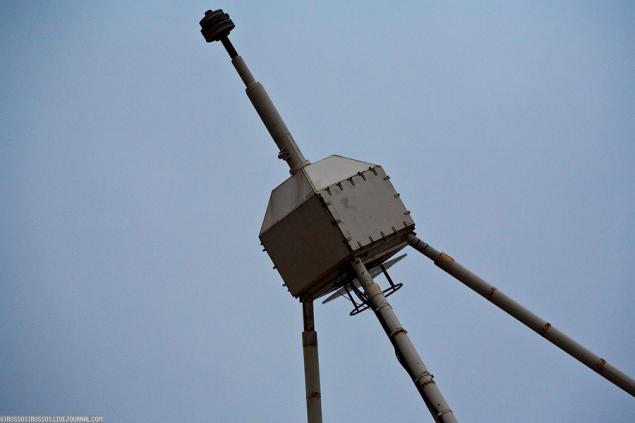
9. The weight structure is more than 450 tons. Diameter reflector telescope - 22 meters. The sheets are fixed to the surface of the reflector adjustable studs, allowing to achieve high mounting accuracy of the reflecting surface.

10. This equipment room, in the center of the device shows the azimuth and elevation angle of the telescope. Hence, also manages the radio telescope. Next set ordinary IBM PC computer, which duplicated the opportunity to control the position of the radio telescope.

11.

12.
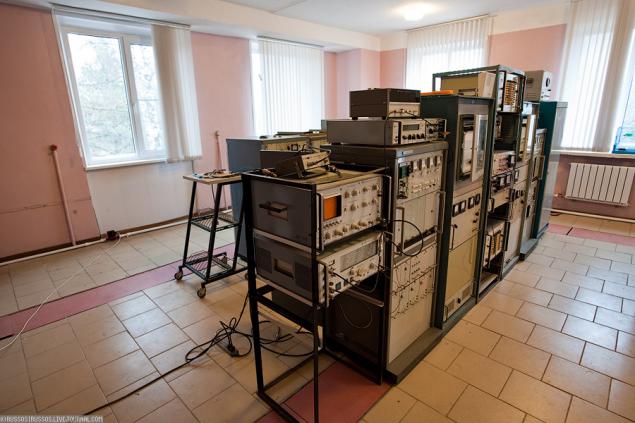
13.
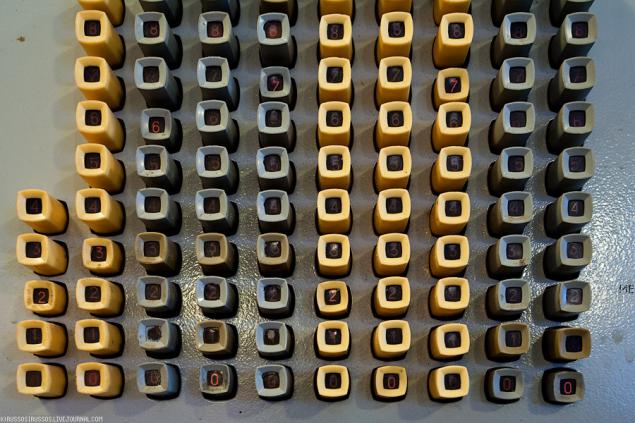
14.

15.

16. The bed on which the telescope - a three-gun barbet 152mm tower unfinished and dismantled in the 50's cruiser. Vadim thinks that it was a cruiser Project 68 bis. Last surviving ships of this type - "Mikhail Kutuzov" Novorossiysk is a museum.

17. The pinion rotary actuator.

18. concertina wire cable is information on adopted and uzhaty to 200 MHz signal is transmitted into the house next to the telescope. Cable length is enough for one revolution after which the telescope has to spin back. This one is not particularly annoying, because the general direction of the telescope - south. They say, however, that once a student telescope swung farther than it should, and broke all the cables. Month restored and then put kontsevichki Limit.

19. But Barrett inside a feeling that you are on the ship. Rivets, centimeter iron and anguish.

20. The motor that rotates the telescope in azimuth.

21.

22.

23. The carriage room. Established various accessories.

24. From this console, you can control the position of the reflector. The control group left - bearing right - elevation. WHEEL in each group are signed as "Speed" and "Angle".

25. Counter the telescope and the drive angle.

26. Do you know what astronomers call their telescopes? Tool! We have before us a tool with a mirror diameter of 22 meters.
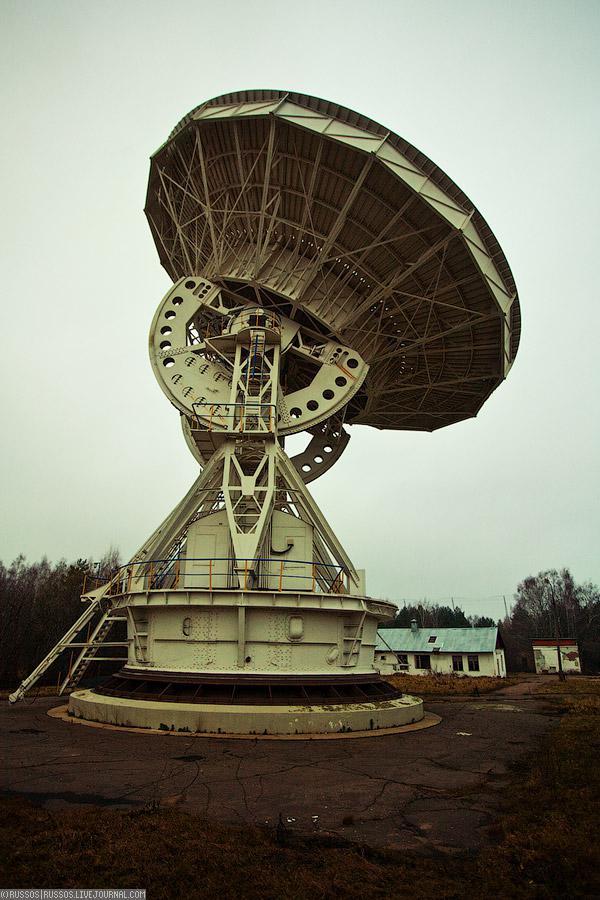
27. And a few words about the space radio telescope of MCT-10. Here, on the territory of the observatory was built a special site for testing and calibration of the rotary mechanism of MCT-10. The building of the landfill has a huge sliding roof, under which the test was fixed radio telescope. Following the successful testing of the telescope he was taken away.

28. Run the project RadioAstron scheduled for June 21, 2010. Soon. By the way, yellow frame - a German foundation for some of the military telescope, which is somewhere in the east watching the sky. After the collapse of the Union of the telescope he was thrown, and base frame saved.
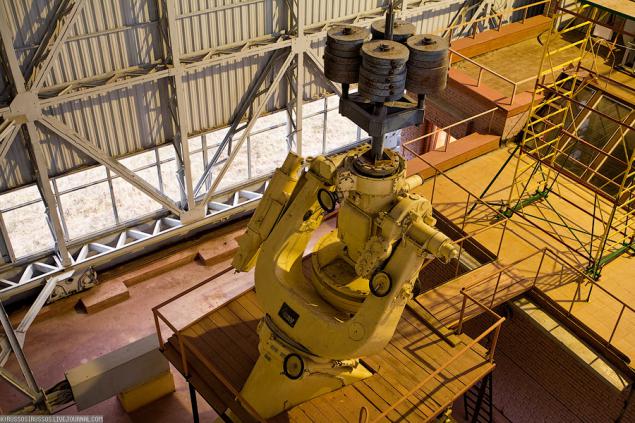
Source:
Pushchino Radio Astronomy Observatory, Astro Space Center - the oldest scientific institution in Russia, engaged in radio astronomy.
It was founded April 11, 1956, when the Order was signed by the Council of Ministers authorizing the USSR Academy of Sciences to build in the Serpukhov district building a radio astronomy station of FIAN and install on the station Radio Telescope.
28 ph © Russos
1. LPI BSA radio telescope - this array, consisting of 16,384 vibrators located on an area of more than 7 hectares.

Now in the observatory are two and a half (the telescope DKR-100 is only east-west axis. The axis of North-South due tsvetmetchikov incapacitated) radio telescope:
1. The radio telescope RT-22 LPI - a radio telescope with a parabolic reflector with a diameter of 22 m. Was put into operation in late 1958, and was the world's first major radio telescope capable of operating in the millimeter wave band. Work on the creation of this telescope was conducted over several years at the Physics Institute. Lebedev USSR Academy of Sciences, with the participation of a number of design organizations and industrial enterprises. The supervisor of works on creation of the radio telescope was the USSR State Prize Laureate, Dr., AE Salomonovich, chief designer - Ph.D., PD Kalachev.
2. Radio telescope DKR-1000 - radio telescope of the meridian type unfilled aperture, consists of two antennas North-South and East-West, located in the shape of a cross. This tool is working only east-west direction.
3. The radio telescope BSA FIAN - this array, consisting of 16,384 vibrators located on an area of more than 7 hectares. Operating Wavelength - 3 m., And this range is the most sensitive BSA telescope in the world.
2. Wire the horizon.

3. RT-22 fote array.

4.

5.

6. DKR-1000 against the backdrop of the BSA.

7. Let's finally turn to the classical radio telescope - RT-22.

8. The central container equipment.

9. The weight structure is more than 450 tons. Diameter reflector telescope - 22 meters. The sheets are fixed to the surface of the reflector adjustable studs, allowing to achieve high mounting accuracy of the reflecting surface.

10. This equipment room, in the center of the device shows the azimuth and elevation angle of the telescope. Hence, also manages the radio telescope. Next set ordinary IBM PC computer, which duplicated the opportunity to control the position of the radio telescope.

11.

12.

13.

14.

15.

16. The bed on which the telescope - a three-gun barbet 152mm tower unfinished and dismantled in the 50's cruiser. Vadim thinks that it was a cruiser Project 68 bis. Last surviving ships of this type - "Mikhail Kutuzov" Novorossiysk is a museum.

17. The pinion rotary actuator.

18. concertina wire cable is information on adopted and uzhaty to 200 MHz signal is transmitted into the house next to the telescope. Cable length is enough for one revolution after which the telescope has to spin back. This one is not particularly annoying, because the general direction of the telescope - south. They say, however, that once a student telescope swung farther than it should, and broke all the cables. Month restored and then put kontsevichki Limit.

19. But Barrett inside a feeling that you are on the ship. Rivets, centimeter iron and anguish.

20. The motor that rotates the telescope in azimuth.

21.

22.

23. The carriage room. Established various accessories.

24. From this console, you can control the position of the reflector. The control group left - bearing right - elevation. WHEEL in each group are signed as "Speed" and "Angle".

25. Counter the telescope and the drive angle.

26. Do you know what astronomers call their telescopes? Tool! We have before us a tool with a mirror diameter of 22 meters.

27. And a few words about the space radio telescope of MCT-10. Here, on the territory of the observatory was built a special site for testing and calibration of the rotary mechanism of MCT-10. The building of the landfill has a huge sliding roof, under which the test was fixed radio telescope. Following the successful testing of the telescope he was taken away.

28. Run the project RadioAstron scheduled for June 21, 2010. Soon. By the way, yellow frame - a German foundation for some of the military telescope, which is somewhere in the east watching the sky. After the collapse of the Union of the telescope he was thrown, and base frame saved.

Source:





